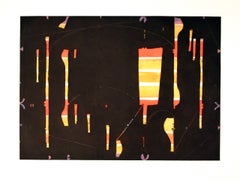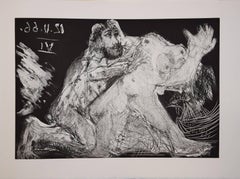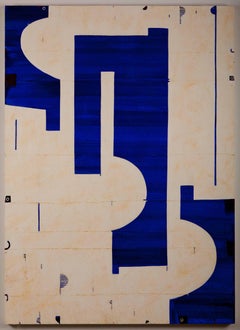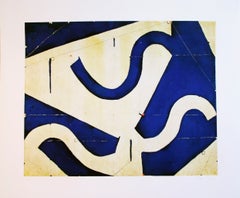Fonseca Caio Art
to
1
Overall Width
to
Overall Height
to
1
1
1
1
1
1
1
1
1
9,989
2,754
1,378
1,375
1
Artist: Fonseca Caio
Dark Stripe
By Fonseca Caio
Located in San Francisco, CA
Color spit bite and sugarlift with soapground and drypoint
Category
1990s Fonseca Caio Art
Materials
Drypoint
Related Items
Le Cocu Magnifique - Complete Suite of Etchings by Pablo Picasso - 1968
By Pablo Picasso
Located in Roma, IT
In-folio Oblong
Dimensions : 29x39 cm.
Paris
Atelier Crommelynck
1968
Edition of 200 copies including 12 original out-of-text etchings (7 etchings, 4 etchings and acquatint and 1 e...
Category
1960s Cubist Fonseca Caio Art
Materials
Drypoint, Etching, Aquatint
$52,468
H 11.42 in W 15.36 in D 2.17 in
Le Couple
By Pablo Picasso
Located in New York, NY
Pablo Picasso (1881-1973), Le Couple, 1951, drypoint on chine volant, signed lower right margin and numbered (5/XI) lower left margin. References: Bloch 690,...
Category
1950s Cubist Fonseca Caio Art
Materials
Drypoint
Tigre couché à l'entrée de son antre (Tiger Lying at the Entrance to its Lair)
By Eugène Delacroix
Located in Middletown, NY
Etching, drypoint, and roulette on watermarked Hallines cream laid paper, 3 3/4 x 5 7/8 inches (95 x 148 mm), full margins. A very good impression of this charming image, with all of...
Category
Early 19th Century Realist Fonseca Caio Art
Materials
Laid Paper, Drypoint, Etching
Low Country (South Carolina)
By Elizabeth Verner
Located in Middletown, NY
An enchanting Southern landscape by the mother of the Charleston Renaissance, Elizabeth O'Neill Verner(1883-1979)
Etching and drypoint on cream wove paper, 6 15/16 x 5 1/16 inches (175 x 128 mm), full margins. Signed, titled and numbered 72/100 in pencil, lower margin. Uniform age tone, minor surface soiling. A rich and inky impression of a magical southern landscape with figure tilling soil under Spanish moss covered oaks.
A native of Charleston, South Carolina...
Category
1930s American Modern Fonseca Caio Art
Materials
Drypoint, Etching
Christmas print, hand coloring in oil stick, Signed, Framed
By Jim Dine
Located in New York, NY
Jim Dine
The Christmas Print (Burg, 26), 2001
Drypoint, direct gravure, etching over offset lithograph with hand coloring by artist in oil stick, on T.H. Saunders paper, the full she...
Category
Early 2000s Pop Art Fonseca Caio Art
Materials
Oil Crayon, Drypoint, Etching, Offset
$18,000
H 15 in W 21 in D 1.5 in
Salvador Dalì (1904–1989) - The Horse and the Wolf-drypoint etching with stencil
By Salvador Dalí
Located in Varese, IT
drypoint etching with stencil on extremely fine Japanese paper , Edited in 1974
Limited edition, numbered 245/250 in lower left corner.
Signed in pencil by artist in lower right corn...
Category
1970s Abstract Fonseca Caio Art
Materials
Drypoint, Etching
Salvador DalíSalvador Dalì (1904–1989) - The Horse and the Wolf-drypoint etching with stencil, 1974
$4,292
H 37.6 in W 31.5 in
UNE JETEE EN ANGLETERRE
By Félix Hilaire Buhot
Located in Portland, ME
Buhot, Felix (French, 1847-1898). UNE JETEE EN ANGLETERRE. B & G 132, State two of eight. Etching with drypoint, aquatint and roulette, 1879. Signed in pencil, and with the red owl...
Category
1870s Fonseca Caio Art
Materials
Drypoint, Etching, Aquatint
Venus
By James Abbott McNeill Whistler
Located in New York, NY
James Whistler (1834-1903), Venus, 1859. Etching and drypoint, printed in black ink on laid paper, an impression in the second (final) state: there was no published edition. 6 x 9 inches (15 x 22.6 cm) sheet 73/8 x 117/8 inches (18.8 x 30.3 cm) Reference: Kennedy 59; Glasgow 60
A very fine impression.
A study of Héloïse, ‘Fumette’, asleep in bed, her head pressed into the pillow and the bedclothes covering her lower legs. This is one of three portraits Whistler made of Fumette in 1859: one of the others shows her standing and in the third only her head and shoulders are depicted. Venus is a work in the Realist tradition, and may be compared with Courbet’s nudes of the same period. The artist may also have had in mind Rembrandt’s study of Antiope in his etching Jupiter and Antiope.
Venus was never published and there is no record of it being shown until 1898 when it was included in an Exhibition of Etchings, Drypoints and Lithographs by Whistler at H. Wunderlich & Co., New York. To have been overlooked for exhibition until so late in Whistler’s life might suggest that the subject was considered improper. Frederick Wedmore, whose catalogue of Whistler’s etchings...
Category
1850s Impressionist Fonseca Caio Art
Materials
Drypoint, Etching
Etching 1916 Number II
By Wassily Kandinsky
Located in New York, NY
Wassily Kandinsky (1866-1944), Etching 1916 Number II, drypoint, signed in pencil lower right, titled, numbered (No. 9) and dated lower left [also with initials and date in the plate lower right]. Reference: Roethel 154, only state, edition of 10. In excellent condition (the barest handling fold at sheet edge), printed on a heavy ivory wove paper, the full sheet with full margins, 4 7/8 x 3 1/4, the sheet 17 1/2 x 13 inches, archival mount with window mat.
A fine fresh impression of this great rarity, printed in a dark brown ink.
Kandinsky created this drypoint (erroneously named Etching 1916) in early 1916 while staying with Gabriel Munter in Stockholm during the winter of 1915-16. This is from the second series of drypoints he made; the first was in the year 1913-14.
Provenance: Kornfeld Auction, Bern, June 2007.
The tiny size of this edition (10) makes this print a great rarity within the Kandinsky’s printed...
Category
1910s Abstract Fonseca Caio Art
Materials
Drypoint
The Mill, Amsterdam, 1889
By James Abbott McNeill Whistler
Located in New York, NY
James Whistler (1834-1903), The Mill, 1889, etching and drypoint, signed in pencil with the butterfly on the tab and inscribed “imp”, and inscribed “first state” (twice) and annotated “Wunderlich” and signed again with the butterfly verso. Reference: Kennedy 413, first state (of 5). Glasgow 457, second state (of 6; see discussion below) (cf. Margaret F. MacDonald, Grischka Petri, Meg Hausberg, and Joanna Meacock, James McNeill Whistler: The Etchings, a catalogue raisonné, University of Glasgow, 2011)
On laid paper, in very good condition, trimmed just outside of the platemark all around except for the tab by the artist, 6 1/4 x 9 3/8 inches.
A very fine impression of this great rarity, printed in black/brown ink with a slight veil of plate tone.
provenance:
H. Wunderlich & Co., New York
Louis B. Dailey, New York (Lugt 4500)
sale, Sotheby’s, New York, October 31, 2003, lot 69
literature;
Neue Lagerliste 122: James McNeill Whistler – Etchings...
Category
1880s Impressionist Fonseca Caio Art
Materials
Drypoint, Etching
One Can't Tell Why - Proof from the Disasters of War
By Francisco Goya
Located in New York, NY
Francisco José de Goya y Lucientes (1746 Fuendetodos – Bordeaux 1828), No se puede saber por qué – One can’t tell why ca. 1808–1814, etching, burnished aquatint, drypoint, an...
Category
1810s Old Masters Fonseca Caio Art
Materials
Drypoint, Etching, Aquatint
The Bridge, Santa Maria
By James Abbott McNeill Whistler
Located in New York, NY
James Whistler (1834-1903), The Bridge, Santa Marta, 1879-80, etching with drypoint, printed in sepia on fine laid paper. Signed with the butterfly and inscribed imp on the tab (also with an exceedingly light butterfly lower right in the plate). Kennedy 204, probably eighth (final) state; Glasgow 201, probably state 9 (of 9) (cf. Margaret F. MacDonald, Grischka Petri, Meg Hausberg, and Joanna Meacock, James McNeill Whistler: The Etchings, a catalogue raisonné, University of Glasgow, 2011), Lochnan 199. Trimmed to the platemark by the artist, h: 11.8 x w: 7.9 in / h: 30 x w: 20.1 cm.
A fine impression, printed with subtle tone.
The bridge theme occurs repeatedly in Whistler’s vistas. It is also the main focus of more than one of the Venetian prints. While some bridges are seen from below, from where one would see it if approaching in a gondola (for example Ponte del Piovan, Kennedy 209), The Bridge depicts the scene from a high perspective, opening up the view into the far distance. The small boat approaching the arch in the foreground is again, as in the earlier Thames prints, a stock motif that is probably ultimately derived from the Japanese woodcuts of Hokusai and Hiroshige. The bridge here is the Ponte de le Terese over the Rio de l’Arzere in the Santa Marta quarter.
The early biography of Whistler by Elizabeth and Joseph Pennell is essential for its “immense quantity of information” but also notorious for “the inherent hyperbole and misinformation” (Eric Denker, Annotated Bibliography, in Fine, p. 184). Still, it is worth quoting from the Pennels’ appraisal of The Bridge: “Simplicity of expression has never been carried further. Probably the finest plate, in its simplicity and directness, is The Bridge. Whistler now obtained the quality of richness by suggesting detail, and also by printing. In The Traghetto...
Category
1870s Impressionist Fonseca Caio Art
Materials
Drypoint, Etching
Previously Available Items
Pietrasanta C10.51
By Fonseca Caio
Located in Fairfield, CT
Caio Fonseca, American, born 1959, was raised in New York City. In 1978 he went to Barcelona where he studied and painted until 1983. He moved to Pietrasanta (Lucca) in 1985 where he...
Category
21st Century and Contemporary Abstract Fonseca Caio Art
Materials
Canvas, Mixed Media
Blue Invention
By Fonseca Caio
Located in San Francisco, CA
Edition of 50
Category
1990s Fonseca Caio Art
Materials
Etching, Aquatint
Fonseca Caio art for sale on 1stDibs.
Find a wide variety of authentic Fonseca Caio art available for sale on 1stDibs. Customers who are interested in this artist might also find the work of William Wegman, Nancy Spero, and James Brown.



